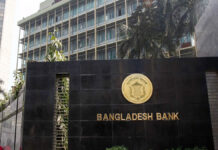
A file photo shows a portion of the Moghbazar-Mouchak Flyover in Dhaka. Bangladesh economy grew by 7.1 per cent, 0.05 percentage points higher than the government’s estimation, in the last fiscal year 2015-16 on sustained consumption, increased public investment, and revived exports, according to the Asian Development Bank.
Bangladesh economy grew by 7.1 per cent, 0.05 percentage points higher than the government’s estimation, in the last fiscal year 2015-16 on sustained consumption, increased public investment, and revived exports, according to the Asian Development Bank. The government estimated that the country’s GDP grew by 7.05 per cent in the last year. The Manila-Based multilateral lending agency on Tuesday revised the GDP growth for the year for Bangladesh up from its previous projection of 6.7 per cent made in the Asian Development Outlook released in last March. The ADB released the ADO Update titled ‘meeting the low-carbon growth challenge’ on the day. ‘In Bangladesh, estimated growth in the FY 2016 exceeded the forecasts because robust performance in manufacturing and services more than compensated for unexpected weakness in agriculture,’ said that report. Increased consumption and public investment contributed to the better performance in Bangladesh in 2016, it said. Inflation was lower than projected, while larger exports and modest imports kept the current account in a larger surplus, it added. The ADB in its ADO Update, however, retained its 6.9 per cent growth projection for the current fiscal year for Bangladesh saying that a slower growth forecast for the year is retained as agriculture growth is expected to be moderate. In March, the bank forecast the Bangladesh economy would grow by 6.9 per cent in the FY 2017. Bangladesh now sees slightly faster expansion in 2016 than anticipated, it said. Bangladesh’s economy recovered from the lower global demand on robust demand for its garment exports. The South Asian economy grew by 6.9 per cent in last year and projected to grow by 7.3 per cent in the current fiscal year, the report projected. Among South Asian countries, India achieved 7.4 per cent, Bhutan 6.4 per cent, Sri Lanka 5 per cent and Pakistan 4.7 per cent GDP growth in last year. The report said that Bangladesh along with Vietnam was well positioned to take over the labour-intensive segments of cross-border supply chains vacated by China. Some developing economies are well positioned to benefit from growth moderation and structural shifts in China. Bangladesh, India, Vietnam, and other members of the Association of Southeast Asian Nations (ASEAN) face the intriguing prospect of replacing China in labour-intensive segments of global value chains as global demand rises for the range of products that China currently produces, from clothing to consumer electronics, it said. The report also said that developing Asia’s physical features and socio-economic conditions leave the region particularly exposed to climate risks. Populations living in low-lying areas, especially along coasts, will suffer the most. Flooding and cyclones in the Indian Ocean already pose threats to low-lying countries like Bangladesh. ‘From 2000 to 2015, disasters such as floods and storms caused losses from damages to property, crops, and livestock totaling US$ 6 billion in Bangladesh,’ the report said.
Source: New Age









